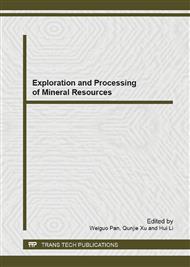p.391
p.395
p.403
p.408
p.412
p.417
p.423
p.429
p.433
Optimization Study on Flotation Conditions of Complex and Refractory Lead Oxide Ores
Abstract:
The optimization condition of flotation reagents of complex and refractory lead oxide ores from Yunnan was studied in this paper. Based on the research on the properties of the material, the grinding fineness and reagent dosages were investigated and a technological flowsheet consisting of one roughing flotation, two scavenging flotation and two concentrate flotation was adopted. The optimum parameters of flotation experiment were determined as grinding fineness of 85%, dosage of sodium silicate at 800 g/t, dosage of Na2S at 1200 g/t and dosage of isoamyl xanthate at 600 g/t. Under such a condition, a lead recovery of 76.55% with a concentrate grade of 58.67% was obtained, which effectively improved utilization of lead resource.
Info:
Periodical:
Pages:
412-416
Citation:
Online since:
December 2013
Authors:
Keywords:
Price:
Сopyright:
© 2014 Trans Tech Publications Ltd. All Rights Reserved
Share:
Citation:


